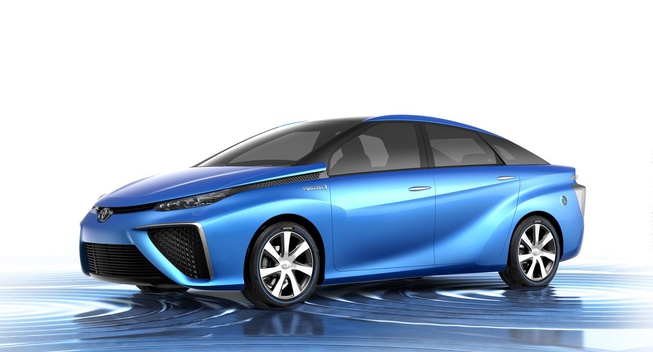Toyota has introduced a hydrogen-powered fuel-cell vehicle to its North American market at the 2014 CES in Las Vegas. Although technically a concept, the company says a production version of the FCV (fuel-cell vehicle) will go on sale in the U.S. sometime in 2015. This confirms, at least to me, we are at the new dawn of the electric car, whether its power is stored in a battery or generated by a fuel cell. The discussion should be of interest to the utility industry, and the wind industry in particular, because that battery will eventually need charging or the fuel-cell tank will need refilling with hydrogen electrolyzed from water.
The announcement suggests that Toyota has taken sufficient cost and size out of the fuel cell, improved its reliability, and is ready to duplicate its Prius success. Left Lane News (leftlanenews.com) says the car will have about a 300 mi. range. Trendy Californians will be happy to assist with the rollout by reportedly chipping in $200 million to build 20 hydrogen filling stations by 2015 and 100 by 2024
Toyota (toyota.com) also promises that the production FCV will be capable of accelerating from 0 to 60 mph in about 10 sec. Unlike conventional battery-powered vehicles that can take hours to recharge, the FCV’s hydrogen tanks can be filled in about three minutes. “Fuel-cell-electric vehicles will be in our future sooner than many people believe, and in much greater numbers than anyone expected,” says Bob Carter, a Toyota VP.
Electric-vehicle manufacturer Tesla makes an equally sexy battery-powered car which it says has a max 265-mi range (at 55 mph) and 0 to 60 mph in 4.2 sec, and you can recharge this one in your garage overnight.
Tesla (teslamotors.com) says its model S will cost only $610 per month after fuel savings. I’d speculate that Toyota’s FCV will lease for less than $600/month. Tesla founder Elon Musk, sensing a little unwanted competition, says fuel-cell vehicles are so much manure. Let’s let the free market decide.
If clean air is important then the time is right for these cars, and more importantly, not just here. China and India are planning new coal plants while Germany, having put a pox on nuclear power, will be importing more coal.
In the next three or four years, it’s not hard to envision two cars powered by different technologies in more garages – an electric or FC vehicle for short trips, and one with an IC engine for longer journeys.
Of course, this is idle speculation but stranger things have happened. For instance, some genius chemist in France might announce next month she found a way to produce zinc-air batteries with double the charge of a similarly sized lithium battery and less expensively. That would change everything.
Frankly, I hope both cars are successful because each will place more demand on electric power and ideally, power from wind farms. Commuting to work on wind power is a more appealing idea than just doing so in an electric vehicle. More EVs will keep this country from buying oil from countries that do not wish us well, and a successful EV industry will spread around the world letting other countries clean up their dirty air. Industries grow, more people go to work, everyone wins.
That’s what I think. What do you think?
–Paul Dvorak
Filed Under: News







I guess everything depends upon where you get your electricity from, whether for recharging your EV or hydrolyzing your water. I can understand how, in the car-saturated US, lots of EVs or FCVs means a shift away from our limited oil supplies toward our extensive domestic coal, NG, wind, hydro and nuclear supplies. Globally, how do EVs net us cleaner air, if you simply shift from IC oil (lots of energy for your fossil fuel buck) to coal/NG electricity — far less efficient after generation and distribution–?
You’re quite right, Glen, that if the power comes from coal or oil, the exercise in EVs could be futile. But some utilities will let you buy wind power (green electrons, I guess) and that could justify the EV or FCV. A colleague in Austin, which is mostly wind powered, drives a Nissan Leaf and so in essence, drives on wind.